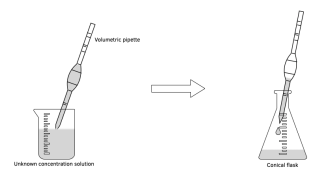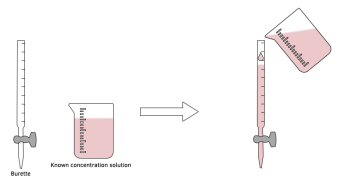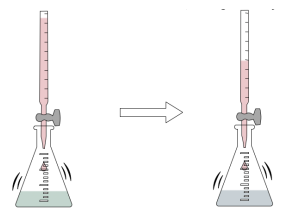Transition Metals - Redox Titrations (A-Level Chemistry)
Redox Titrations
Redox Titrations
Redox titrations are performed in the same way as acid-alkali titrations to determine the concentration of an unknown solution.
However, redox titrations involve transition metal ions in redox reactions. Colour changes are observed as the transition metal ions change oxidation state. The colour change occurs at the end point of the titration.
Here are the stages in carrying out the titration:
1. Measure a known volume of solution. Place a known volume of solution of unknown concentration using a volumetric pipette, in a conical flask.

2. Add excess sulfuric acid. Use a measuring cylinder, add about 20 cm³ of dilute sulfuric acid to the flask. This needs to be in excess.
3. Fill a burette with a known volume of solution. Fill a burette with the solution of known concentration of solution.

4. Add the solution to the conical flask. Add the solution from the burette to the conical flask, swirling constantly.
5. Record the volume at the colour change. Slow down the flow to drop wise as the colour begins to change. When the colour changes, stop the flow and record the volume of titre used.

6. Repeat twice. Repeat until you get two concordant reading (to within 0.10 cm³)
7. Derive the half-equations. Derive the half equations for the reactions involved.
8. Calculate the unknown concentration. Use the mole ratios from the half-equations to calculate the unknown concentration.
Transition metals are elements found in the middle of the periodic table and are characterized by having partially filled d-orbitals in their electron configuration. Some common examples of transition metals include iron, copper, nickel, and silver. These metals are known for their ability to form complex ions and to readily participate in redox reactions.
Redox titrations are a type of analytical method used to determine the concentration of an unknown substance by reacting it with a known amount of another substance. In these titrations, a redox reaction takes place between the unknown substance and the titrant, and the progress of the reaction is monitored using a suitable indicator or by measuring the electrical potential of the reaction mixture. The endpoint of the reaction is determined, and from this information, the concentration of the unknown substance can be calculated.
Transition metals play a crucial role in redox titrations as they often participate in redox reactions as oxidizing or reducing agents. Many transition metals form complex ions that can serve as effective oxidizing or reducing agents in redox titrations. For example, transition metal ions such as iron (II) or copper (II) can act as oxidizing agents in the reaction, while transition metal ions such as iron (III) or copper (I) can act as reducing agents.
Redox titrations have a wide range of applications in various industries and research areas. Some common applications include determining the concentration of a variety of substances, such as ions, oxygen, and antioxidants, in aqueous solutions. They are also used in the analysis of food and pharmaceuticals, to monitor the purity of chemicals, and to determine the stability of chemical compounds.
A redox titration experiment typically involves several steps. First, the unknown substance and titrant are prepared, along with a suitable indicator or a potentiometer to monitor the progress of the reaction. Next, the unknown substance is added to the reaction flask, followed by the titrant. The reaction mixture is stirred, and the indicator or potentiometer is used to monitor the reaction until the endpoint is reached. The endpoint can be determined by observing a change in the color of the indicator or by measuring the electrical potential of the reaction mixture. Finally, the data collected during the experiment is used to calculate the concentration of the unknown substance.
The main advantage of redox titrations is that they are versatile and can be used to determine the concentration of a wide range of substances. They are also relatively easy to perform and can be performed using simple laboratory equipment. Some disadvantages include the need for a suitable indicator or a potentiometer, and the fact that redox reactions can be influenced by various factors, such as temperature, pH, and the presence of other substances in the reaction mixture, which can affect the accuracy of the results.





Still got a question? Leave a comment
Leave a comment